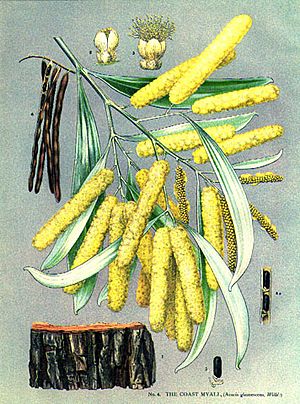Coast myall facts for kids
Quick facts for kids Coast myall |
|
|---|---|
 |
|
| Scientific classification | |
| Genus: |
Acacia
|
| Species: |
binervia
|
 |
|
| Occurrence data from AVH | |
The Coast Myall (Acacia binervia) is a type of wattle plant. It can grow as a shrub or a tree. You can find it naturally in New South Wales and Victoria, Australia. This plant can grow quite tall, sometimes up to 16 meters. Its leaves can be harmful to farm animals if they eat them.
Contents
About the Coast Myall
How Scientists Name It
Scientists give every plant a special name. This helps everyone know exactly which plant they are talking about. The Coast Myall was first named Mimosa binervia in 1798. This was done by a German botanist named Johann Christoph Wendland. Later, an American botanist, James Francis Macbride, changed its name. In 1919, he put it into the Acacia group, so its name became Acacia binervia. People also sometimes call this plant "rosewood."
What the Coast Myall Looks Like
The Coast Myall can be a small shrub or a medium-sized tree. It usually grows between 2 and 16 meters tall. Its bark is dark brown or grey. The leaves are called phyllodes. They are shaped like an oval or a sickle. These leaves are about 6 to 15 centimeters long. They are also about 0.5 to 2.3 centimeters wide.
The Coast Myall has yellow, cylinder-shaped flowers. These flowers appear in spring, usually from August to October. After the flowers, seed pods grow. These pods are about 6 to 8 centimeters long. The seeds inside are ready by December.
Where the Coast Myall Grows
You can find the Coast Myall in central New South Wales. It grows from the Hunter Region southwards. It also grows near Bungonia in the southwest. The plant continues to grow south into Victoria.
In the Sydney basin, it grows in many different types of soil. These include soils from rivers, sandstone, shale, or trachyte. It usually prefers soils that drain water well. It grows in dry sclerophyll forest. Here, it can be found with trees like yellow bloodwood (Corymbia eximia) and grey gum (Eucalyptus punctata). It also grows in more open woodlands. These areas might have narrow-leaved ironbark (E. crebra) and black cypress pine (Callitris endlicheri). You can also find it near rivers. In these places, it grows with river peppermint (E. elata) and gossamer wattle (Acacia floribunda).
How it Survives and Helps Nature
The Coast Myall has a special way to survive bushfires. Its seeds are in the soil. When a fire happens, the adult plants might die. But the heat from the fire helps the seeds to sprout and grow. For this cycle to keep going, fires need to happen every 10 to 50 years. This plant is also helpful for bees. It provides them with nectar and pollen, which helps in making honey.

